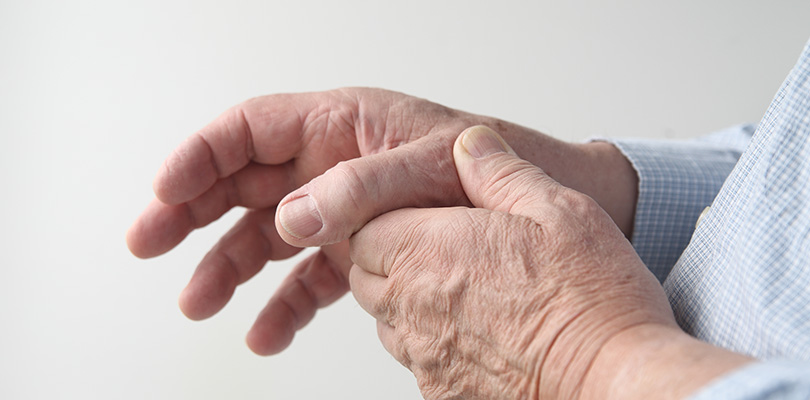Shoulder Arthritis
Your body is full of joints which serve to connect your bones and aid movement. Especially as we age, these joints put in many bends, rotations, lifts, and other repetitive motions that can turn into areas of pain and inflammation. Your shoulder joints are no different and given enough time or circumstance – shoulder arthritis may become part of your reality.
What Is Shoulder Arthritis?
The shoulder has two joints, and shoulder arthritis generally references the bigger joint (the ball and socket joint), called the glenohumeral, or G-H, joint; it's the joint that connects the glenoid and humerus bones.
Shoulder arthritis happens when the cartilage on the ball or socket sides of the shoulder joint begins wearing down, first on the surface then gradually into the deeper layers to cause irregular motion.
Arthritis can also develop in the second shoulder joint, this type of arthritis is called A-C joint arthritis (since it occurs in the acromioclavicular, or A-C, joint). Shoulder arthritis can eventually lead to pain, inflammation, and loss of motion in the shoulder.
Causes of Shoulder Arthritis
Shoulder arthritis is usually the result of gradual wear and tear of the cartilage, developing with age (often in people over 50). The cartilage wears away at different rates in different parts of the joint and happens in a few stages.
First, the cartilage softens, develops cracks in the surface, eventually starts to erode and flake, and it finally wears away enough to expose the bone beneath. Without the cartilage, there is no smooth, gliding surface for the joint, so the bones within the joint create friction by rubbing against each other to cause that not-so-pleasant grinding sensation.
Types of Shoulder Arthritis
The number of types of arthritis is in the triple digits. Here are the top four types of shoulder arthritis:
- Osteoarthritis in the shoulder is a degenerative joint disease related to the wear and tear of getting older. It is generally a gradual process that sees the cartilage erode over time.
- Rheumatoid arthritis of the shoulder is an autoimmune disease where your body's defenses attack healthy cells lining the joint in the shoulder (or both shoulders at the same time).
- Rotator cuff tear arthropathy develops after a massive and prolonged rotator cuff tear. There are four of these tendons in your shoulder which wrap around the ball of the shoulder joint to keep it in place. If any of these tendons tear, it can cause the head of the humerus to rub against other bones, which encourages the development of arthritis. A large rotator cuff tear and later stage arthritis can result in pain and weakness that may mean that you're unable to lift your arm.
- Post-traumatic shoulder arthritis may develop if your shoulder was previously injured due to fracture or dislocation.
Symptoms of Shoulder Arthritis
- Pain in the shoulder joint is a major indicator of arthritis. Pain generally feels worse when performing certain activities such as lifting, carrying, or after exercising. Reaching over the head can be particularly bothersome, and changes in the weather may also generate aching within the joint.
- Stiffness and reduced range of motion in the shoulder may leave you with limitations with your arms' ability to do routine activities. Not everyone with arthritis experiences reduced range of motion.
- Crepitus is the grinding or clicking that can be felt with shoulder arthritis. It may not be painful, but it sometimes causes the shoulder to lock up.
- Night pain can affect your ability to get quality sleep.
- Bone cysts or bone spurs may also develop (and will show up in the x-ray during diagnosis).
Following an arthritis diet plentiful in fruits, vegetables, fish, beans, and nuts are good for your body and reducing pain overall.
Treatment for Shoulder Arthritis
There is no way to prevent shoulder arthritis, but there are several treatment options available.
There are several non-operative treatments available, which include:
- Medications for pain relief may help control your pain levels, but with any prescription or over the counter drug, consult a doctor or pharmacist for proper instructions.
- Range of motion exercises helps keep the shoulder mobile. These exercises should be done even if your range of motion is not yet affected. Range of motion exercises are a preventative action, so it's important to stretch during the day (which will help quite a bit).
- Physical therapy is generally only required if you're losing range of motion. Seek the help of a professional, especially if you want to incorporate shoulder exercises into your routine.
- Cut down on activities that create shoulder pain but be sure to advise your doctor of limitations due to discomfort.
- Some dietary supplements, glucosamine, and chondroitin may also help relieve pain, although research into this is ongoing.
- Ice or cold therapy pads can be used for 20-30 minutes a few times a day if required.
- Heat can help warm up a joint before stretching, and some people find that heat agrees with them more than ice.
- Steroid injections contain cortisone and numbing medicine to help with pain and inflammation. This can be a temporary option for relief, but the injection needs to be prescribed and administered by a doctor.
Surgery is available if non-operative treatments aren't providing the required relief. Two common types of surgery are:
- Arthroscopic shoulder debridement surgery involves making tiny incisions to clean out the inside of the shoulder joint. This type of surgery is for low-grade arthritis where there isn't bone-to-bone friction.
- Total shoulder replacement surgery replaces the ball and socket in the shoulder with artificial replacement parts and lasts for many years. There are other types of shoulder replacement surgeries that are less common; you can learn more from your surgeon about these types of surgeries.
Once you notice that your shoulders aren't feeling the way they used to, don't put off getting the issue looked at. With an early diagnosis, you'll find ways that relieve the inflammation and pain associated with shoulder arthritis.







